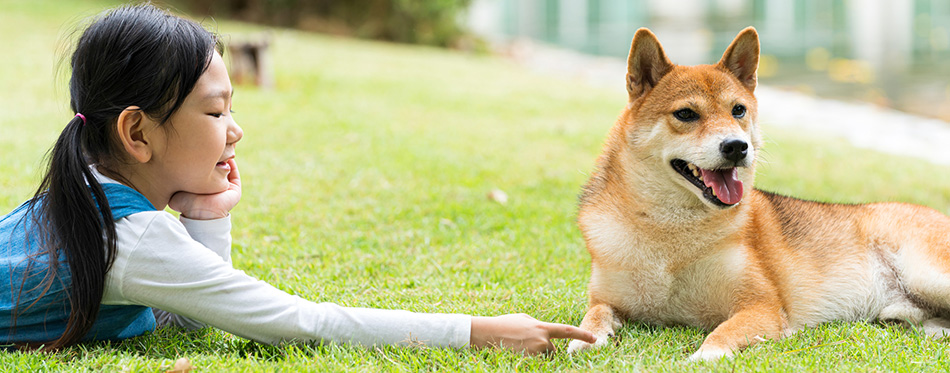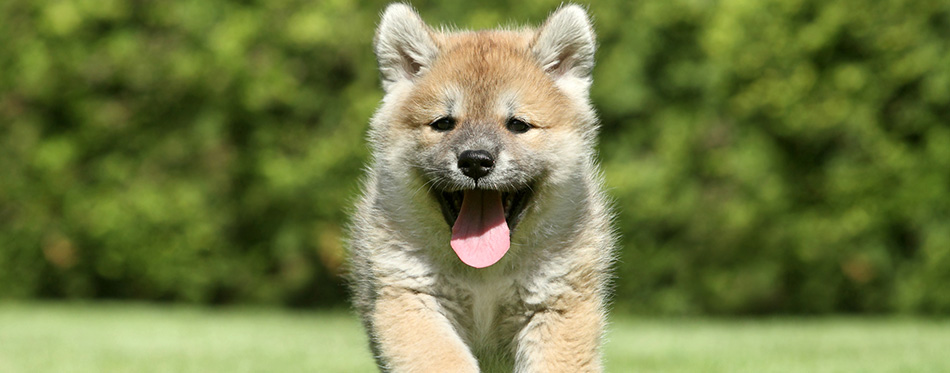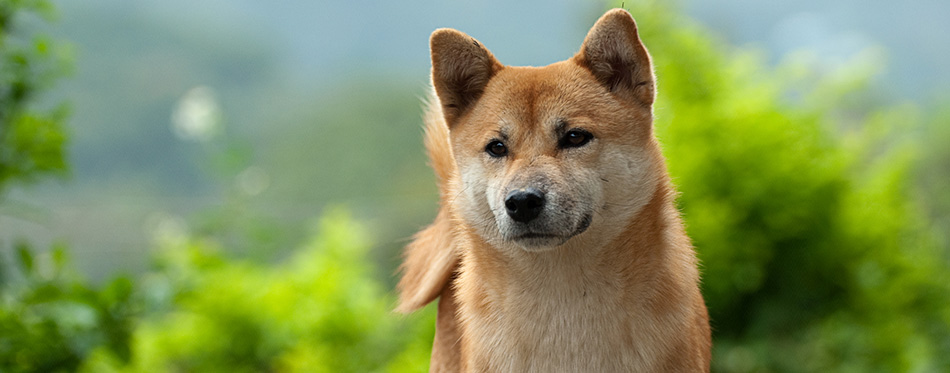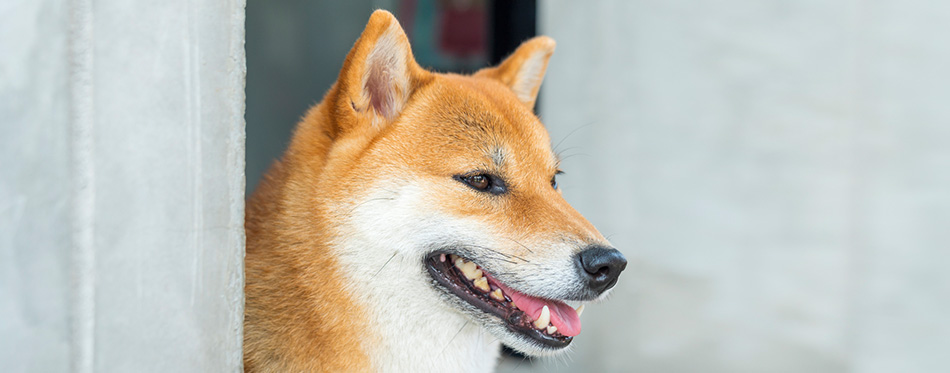With its bubbly and charming personality mated to a foxlike appearance and a demeanor that resembles more of a kitty’s, there’s really nothing to hate about the Shiba Inu except when it comes to training. As adorable and intelligent as these Japanese National treasure dogs are, they can be very stubborn as any other Spitz type of dog. It’s compact and quite a joy to have as a pet, though, if you can find the courage to be its true master. If you have the qualities of a person that the Shiba will look up to, then maybe this can be the dog of your dreams. Shall we find out?

History of the Shiba Inu
Before we take on a rather lengthy journey discovering the origins of the Shiba Inu, let’s try deciphering these two words that make up the name of the breed first.
The word “Shiba” is not really a place in Japan. Rather, it is the local word for brushwood. So, when you combine it with “Inu” (which means ‘dog’ in Japan, by the way), then you have a ‘brushwood dog’ or a canine that hunts in the brush. But then, brushwood also refers to plant life that turns its leaves into red as soon as autumn sets. It is possible that the Shiba they call this dog refers more to the most common color of these dogs which is red. There is also reason to believe that the word “shiba” may mean ‘small’ if one is to refer to an ancient Nagano dialect. It is no wonder that the Shiba Inu is also colloquially called the ‘little brushwood dog’.
Now let’s look at the history of this brushwood dog.
Shiba Inus are a Spitz type of dog that share much resemblance with the likes of the Samoyed, Alaskan Malamute, and even the Siberian Husky. Spitz type of dogs originated from the Arctic regions, more specifically from Siberia. They have been in existence for more than 8,000 years. These early Arctic dogs migrated southwards in search of food.
Moving southwest, some these dogs found themselves in the Alpine mountains of central Europe. Some moved southeast into Manchuria. It is believed that the Shiba Inu’s ancestors are the Spitzes coming from Manchuria since this Chinese region runs opposite the island of Japan, separated only by the Sea of Japan.
Shiba Inu fanciers say that the dog has been in Japan since 300 BC, although it is possible that they have been here since 6000 BC. This makes them the oldest of Japan’s native dogs. It is not surprising, therefore, that the breed is one of the nation’s National Monument breeds. It was bred specifically to hunt small game as well as flush them out of their hiding places. They are especially famous for hunting rabbits and birds, although the early Japanese also used them in the hunt for larger game such as deer and wild boar.
These hunting dogs thrived in the mountainous regions of Chubu in central Honshu. In the 19th century, the Meiji Restoration saw the end of the Tokugawa era and its feudal system. It also opened the doors of the country to Western influences with the aim of combining modern advances from the West and the traditional values of the East. It was also around this time that western dog breeds were brought to Japan and crossbred with the native canine population. This interplay between western dog importers and local Japanese canine breeders introduced many Japanese dogs to the outside world. Many of these eventually became popular outside Japan.
Unfortunately, the crossbreeding of local dogs and imported ones saw the rapid decline in the number of purebred native dogs such as the Shiba Inu. For more than 14 years from 1912 to 1926, only a handful of purebred Shibas were left. Two years later in 1928, Japanese intellectuals and even hunters were alarmed at the decline of the breed. Efforts were initiated to protect the remaining purebred Shibas.
With a growing sense of nationalism in Japan, a number of cynophilists or dog fanciers sought to make a comprehensive census of Japan’s remaining native dog population. Regrettably, the native dogs were classified according to their geographic distribution such as Akita, Hokkaido, and Shikoku, to name a few. Since Shiba does not represent any of the geographic regions of Japan, it was never really included in the early census.
However, this did not deter Dr. Saito from grouping together native Japanese dogs that had relatively smaller size compared to those classified in geographic regions (remember ‘shiba’ can also mean ‘small’?). The Nihon Ken Hozonkai (Association for the Conservation of the Japanese Dog), also called Nippo, was created in 1932 in an effort to account for these small dogs. Nippo and Shiba fanciers began an extensive breeding program that utilized three different bloodlines of Japanese small dogs (shiba inus). These included the San’in from the prefectures of Shimane and Tottori, the Mino from Gifu prefecture (formerly Mino province), and the Shinshu from the prefecture of Nagano.
The San’in Shiba is a descendant of the Imba and Sekishu, two very ancient Asian spitzes. San’ins are medium-sized dogs (although they are definitely larger than the Shibas we have today) without the characteristic white cheeks that people associate with the modern-day Shiba. These are highly independent dogs with a bold attitude and a surprisingly, almost cat-like lack of affection.
The Shinshu is known as the descendant of Nagano’s ancient spitz, the Mikawa. These are relatively small Shibas with round-shaped eyes with an unusual black mask. It has a solid undercoat complete with guard hairs that are so dense. The Shinshu comes in the characteristic red color of the Shiba.
Mino Shibas are midway between a San’in and Shinshu in terms of size. They have fiery-red color and deep-brown, triangular shaped eyes. Their tails come with a very unusual presentation – that of a sickle – instead of the usual curled. They also have thick ears.
In 1934, Nippo was able to unify these three bloodlines into what is to become the world’s first unified Shiba Inu. Nippo also worked for standardization of the breed, publishing it also around this time. Two years later in 1936, the Japanese government finally gave its due recognition to the Shiba Inu as one of Japan’s National Monument breeds by virtue of the Cultural Properties Act.
The recognition should have allowed the Shiba Inu to flourish. But then World War II broke out. Many of these dogs either died because of starvation or were killed to be used as food for the starving people. The end of the Second World did not offer any comfort as well because canine distemper virus was fast spreading around this time.
Since Nippo was able to publish their work on the San’in, Mino, and Shinshu bloodlines, these dogs were again selected from their respective regions to restart the breeding program for the Shiba Inu. This helped reintroduce the Shiba Inu to the modern, post-WWII world.
An armed service family is believed to have brought the very first Shiba Inu into the United States in 1954. However, it was only in 1979 when a Shiba Inu litter was first recorded. It is very unlikely that this US-born Shiba Inu is the offspring of the 1954 Japanese import, considering the breed only has a maximum lifespan of 16 years. We believe that the Shiba Inu of 1954 was already producing puppies. It took 25 years before somebody thought of having it documented.
Categorized into the Non-Sporting group of dogs, the Shiba Inu gained recognition from the AKC in 1992. As of 2017, it ranks number 45 in the AKC list of popular breeds.

Quick Facts
The Nippo laid the foundation standards of the breed which were subsequently adapted by the Japanese Kennel Club in 1948. However, because the dog was also imported to the US and was eventually recognized by the AKC, it is possible to have slightly different standards depending on which kennel club you belong. Generally, however, the Shiba Inu should have the following characteristics.
- The height should be between 14 and 17 inches for males and 13 to 16 inches for females. The AKC, however, puts the height standards at 14.5 to 16.5 inches for males and 13.5 to 15.5 inches for females.
- A fully grown Shiba should weigh 23 pounds for males and 17 pounds for females, on the average.
- It has a life expectancy of 13 to 16 years.
- They have a foxlike appearance because of the unique combination of reddish coloring and white markings. Ideally, their coat should be red or sesame red. However, it is not unusual that they may come in black and tan coloring.
- If a Shiba comes with a white coat, it is not allowed by the AKC in the show ring. However, this color of Shiba is perfectly acceptable with the British Kennel Club.
- It may be small, but it is moderately-boned and muscular.
- It has a straight, but stiff outer coat while its undercoat is usually thick yet soft.
- There are guard hairs that can grow as long as 1.5 to 2 inches usually located at the dog’s withers or shoulders.
- The hair on the Shiba’s tail is longer and generally stands open resembling that of a brush. This is one of the dog’s distinguishing features from other breeds. Like a fan, they use their tail to cover their faces to protect it against the bitter cold.
- The Shiba should always have an Urajiro marking which means it should always have an underside which is either white or cream. If the base color is red, then the Urajiro markings should be on the front chest, the throat, and the chest. If the base color is either sesame red or black, then the Urajiro marking takes on a more triangular shape located on both side of the dog’s front chest. For all other coat colors of the dog, the Urajiro marking should be present on the sides of its muzzle, the cheeks, under the jaw, inside the ears, on the abdomen, the upper throat, the back side of the tail, and the inside of the legs.
In addition to these characteristics, the Shiba is also well-known for the following.
- They are formidable hunters, having descended from Japan’s mighty hunters of the inhospitable mountain regions.
- It is Japan’s number 1 companion dog.
- The Shiba Inu is one of Japan’s 9 monument breeds or national treasures.
- Shibas are well-regarded as the oldest and smallest of Japanese dogs.
- It is a fastidious breed; a trait that is more associated with cats than dogs. As such, this dog can often be seen licking its limbs, coat, and paws.
- It is also known for the Shiba scream, an unusually loud, high-pitched sound that seems like the shriek of a really frightened girl. It emits this scream when people attempt to handle the Shiba in a way that the dog deems unacceptable. It can also scream when unhappy or provoked.
Things You Should Know
If you think the Shiba Inu is just the dog that you’ve been looking for, you clearly haven’t understood its history. Sure, it can be cute and adorable like a fox, but it does come with a temperament that is more cat-like. Of course, there are cats that are lovable and affectionate, but these are more of exceptions. That being said, here are a handful of things you really have to learn by heart about these dogs.
Training
Rejoice! Training the Shiba is quite easy. Well, that is if you are only going to aim for having it housetrained. Remember what we said about this doggy being super fastidious that it acts more like a cat? Somehow, this breed has some form of canine obsessive-compulsive disorder. It will do anything to keep its coat spot-clean. If you don’t see it playing, it will be in its favorite nook licking its paws and grooming its coat. In terms of housetraining, you can easily put the Shiba outside your house after meals and it will do the rest. Don’t worry; it won’t bring its business inside your house since it doesn’t really like smelly and dirty houses. That is why it is such a pleasant pooch to housebreak.
But that’s just about it. If you’re thinking of teaching it to perform certain tricks or to obey your commands, then good luck with that. Even seasoned dog handlers are known to give up on the Shiba. The thing is that, like the wily fox, this dog will play you. It will test your patience and your perseverance. It will keep on pushing your button, always checking just how far it can go with its crazy antics and stubbornness. For this dog, it is you who needs to follow its wishes and never the other way around.
This is one of the reasons why most people call them being cat-like dogs. Don’t expect the Shiba to follow your commands or to obey your wishes just because you said so (typical cat!). However, if there is something that interests this dog it will lock its focus onto this until it gets it.
Shibas are quite sensitive, too. They get easily hurt (emotionally?). They are like toddlers that will throw temper tantrums if they don’t get what they want. Remember that Shiba scream we were talking about? Well, you’ll hear it very often in a dejected, frustrated, or even bored Shiba. The sad news is that when it goes on a screaming rampage, there’s no controlling the Shiba. The more that you try to control it, the more that it gets out of control (ironic?). It will go into a defensive mode and will snap and bite if you persist.
Does this mean you can skip training the Shiba, after all it can already housetrain itself? The answer is a resounding NO!
All dogs have to be trained. In the case of the Shiba, its cat-like behavior and foxy cunning should be channeled into more positive, constructive ways. Sadly, this is where many dog owners fail. For you to train the Shiba, you should be smarter, wittier, and more cunning than this dog. This is very tricky since there’s no way we can look into the mind of our dogs and learn what it is thinking. Some say you have to make the training session look more like it is the Shiba’s idea. That’s definitely easier said, though.
Passive resistance also helps. This is the same technique that pediatricians teach to parents of toddlers who are throwing temper tantrums. It’s simply ignoring the dog. Sooner or later, it will realize that its ‘bad behavior’ is simply not working.
When training the Shiba, be firm and assertive. Don’t ever convey the message that you are somewhat begging it to follow you. Do you know what you are telling the dog if you do this? For the dog, it is more dominant than you. So, be tough. The same is true when it gives you that sad, give-me-my-doggie-bone look. Resist the temptation to give in. This dog is the wily fox.
Shibas have a never-back-down, never-give-up attitude. As such, they will test your perseverance and patience. If you give up easily, they’ve won. Under no circumstance should you punish the Shiba because of its stubbornness or even craftiness. Remember, it’s a very sensitive hound. Punishing it will only make its behavior worse.
At best, positive reinforcement techniques should be adhered to. If you’re not familiar with these techniques, then a professional dog trainer can help. However, it is important to hire not just any other trainer. Someone who is experienced in handling Shibas is perfect.
One last thing. You’ll have a greater chance of training success with a puppy than an adult Shiba. Therefore, start training the puppy as young as 6 weeks old. A well-trained Shiba can be a real delight for any family especially those who require a loving and affectionate dog.
You may also like our guides on Dog Training Books and Dog Whistles.

Feeding
Puppies require high protein, high fat diets plus the right amounts of calories to support their growing needs. Proteins should always come from animal sources since these are easily digested by the young tummy. As for the fats, always go for omea-3 fatty acids, but most especially DHA as this can help lay the foundation for an optimally functioning brain and eyes. Omega-3s also help ensure healthier skin and coat.
Adult Shibas will also benefit from a good balance of proteins and fats, although it is perfectly okay to add carbs in their diet especially if they lead a very active lifestyle. However, carbs should never comprise more than 50 percent of their diet.
A 15-lb Shiba typically needs about 450 to 470 calories per day. You can thus, give 150 to 160 calories per meal if you decide to feed it 3 times a day. For an adult Shiba, it should be fed at least twice a day.
If you’re giving dog kibbles, make sure that the kibble size is just right for the relatively small mouth of this dog. Wet dog food is perfect, although you’ve got to be ready with the economic implications.
For more guides on choosing the right dog food, you may wish to check out our reviews of the best dry dog food, organic dog food, grain free dog food, dog chews and pig ears for dogs.
Exercise
The Shiba is an active dog and would love nothing more than to run, walk, and even hike with its family. They really don’t need very vigorous exercise. As long as they can walk or run about 45 to 60 minutes every day, then this should be okay. They are also noted for being escape artists. But this doesn’t mean they are going to scale your wall if they don’t get their daily exercise. Nonetheless, a responsible pet parent of a Shiba should still make it a habit to walk the dog.
This can also help address some of the behavioral problems that are seen in such a breed. They may not be as clingy as other dog breeds, but some are known to suffer from separation anxiety as well as depression and boredom. Exercising will give them the channel these energies into more constructive ways.
Socialization
When properly socialized, the Shiba Inu can be a real darling, the apple of the eye of any family. It can even live in peace with cats (after all, it has this cat-like mindset). Some may even share their dog bed with the kitty of the house. The same is true with the rest of the family. It can play with the kids and make affectionate gestures with the adult members. However, being a hunter and a watchdog, the Shiba is especially wary of strangers and will never hesitate to show its reservations. Nevertheless, a socially-trained Shiba will never attack a stranger (whew!).
If you fail in socializing the Shiba, it can be quite aggressive, unfortunately. Whether it is other humans or other pets, the Shiba can be overly protective. It is a very territorial dog, after all. It knows that the moment it came into your house, it is already its house. So it does everything it can to protect it.
Grooming
It’s not really difficult grooming the Shiba, even though it has a double coat. Weekly brushing or combing and once every 6 months bathing is enough. If there’s one thing you really need to prepare for it is its tendency to blow its shed. This occurs seasonally and you’d have to help by brushing it every day. Getting ready with the pet vacuum cleaner should also help manage the snow-like pet hair inside your home.
As always, dental care and ear care should be observed on a daily and weekly basis, respectively. The same can be said of clipping the Shiba’s nails which can be performed once a month.
Check out some of our dog grooming guides, such as dog shedding brush, dog shampoo, dog toothbrush, dog toothpaste and dog wipes.
Health
While the Shiba Inu is a relatively healthy breed, it’s not free from diseases, especially those that are hereditary. Therefore, it is not unusual for Shibas to be prone to allergies, cataracts, patellar luxation, entropion, glaucoma, and hip dysplasia. It’s always best to look at the genetic profile of its parents so you can also have an idea what diseases might be present in this dog.
The Shiba Inu requires a person or a family who…
- Is very patient and persevering especially in training and socializing this foxy, catlike dog
- Understands the principles behind positive reinforcement methods
- Has a strong, assertive, and firm yet calm personality
- Is definitely smarter than the wily dog
Forget owning a Shiba Inu if you…
- Don’t have the patience and perseverance to train and socialize this dog
- Dislike the idea of a dog that sheds a lot, albeit seasonally
- Are not going to socialize or train the dog the correct way

Temperament
Shibas have a really strong prey drive, making them very independent. Unfortunately, this can make them quite aggressive in the eyes of other people. It is well known for its spirited boldness that can be somehow tempered by consistent obedience training as well as early socialization. It has an unaffected forthrightness which can easily translate into arrogance for some people. When socially prepared well, it is very affectionate and loyal to its family and can also be an excellent companion for other pets including cats. It is always reserved towards strangers, however. And this is even with training and socialization.
For very obvious reasons not everyone is entitled to become the pet parent of a Shiba Inu. It is headstrong despite its size. It is dignified yet with the cunning of a fox. Only the toughest and smartest individual can ever gain the respect of the Shiba.
Sources:
- About the Shiba – National Shiba Club of America
- Shiba Inu – AKC

